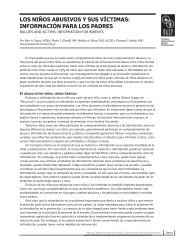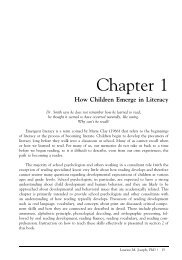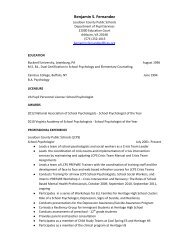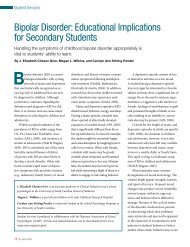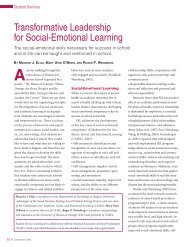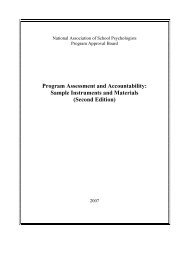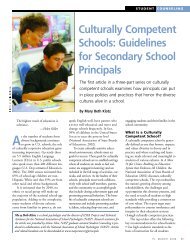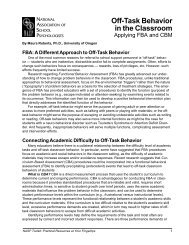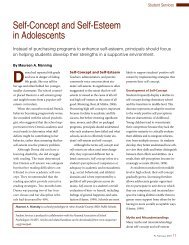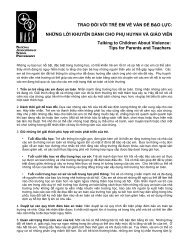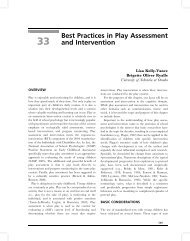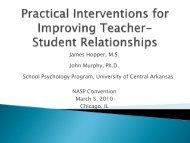Response to Intervention: The Future for Secondary Schools
Response to Intervention: The Future for Secondary Schools
Response to Intervention: The Future for Secondary Schools
You also want an ePaper? Increase the reach of your titles
YUMPU automatically turns print PDFs into web optimized ePapers that Google loves.
conclusion<br />
<strong>The</strong> national education community continues<br />
<strong>to</strong> focus tremendous attention on RTI as an<br />
effective means of improving student achievement<br />
and reducing drop-out rates. <strong>The</strong> U.S.<br />
Department of Education is currently funding<br />
numerous RTI-related research projects<br />
and technical assistance centers, such as the<br />
National Center <strong>for</strong> <strong>Response</strong> <strong>to</strong> <strong>Intervention</strong><br />
(www.rti4success.org). <strong>Schools</strong> throughout<br />
the country are implementing RTI initiatives,<br />
but research is ongoing and implementation<br />
ef<strong>for</strong>ts, especially at the secondary level, are<br />
remarkably inconsistent. Adhering <strong>to</strong> core<br />
RTI components will more likely ensure<br />
successful outcomes. At the secondary level,<br />
these core components are data-based decision<br />
making with multiple sources of data<br />
(including state accountability tests); fexible,<br />
small-group instruction in both skill strategies<br />
and content; and collaborative problem<br />
analysis. PL<br />
reFerences<br />
n Archer, A. L., Gleason, M. M., & Vachon, V.<br />
(2005). REWARDS secondary. Longmont, CO:<br />
Sopris West.<br />
n Burns, M. K., Apple<strong>to</strong>n, J. J., & Stehouwer, J. D.<br />
(2005). Meta-analysis of response-<strong>to</strong>-intervention<br />
research: Examining feld-based and researchimplemented<br />
models. Journal of Psychoeducational<br />
Assessment, 23, 381–394.<br />
n Deno, S. L. (2002). Problem solving as “best<br />
practice.” In A. Thomas & J. Grimes (Eds.), Best<br />
practices in school psychology (4th ed., pp. 37–66).<br />
Bethesda, MD: National Association of School<br />
Psychologists.<br />
n Hasbrouck, J. E., Ihnot, C., & Rogers, G.<br />
(1999). Read naturally: A strategy <strong>to</strong> increase oral<br />
reading fuency. Reading Research and Instruction,<br />
39(1), 27–38.<br />
n Heartland Area Education Agency 11 (2004,<br />
April 1). Heartland AEA 11 annual progress report.<br />
Available online at www.aea11.k12.ia.us/<br />
downloads/2004apr.pdf<br />
n National Association of <strong>Secondary</strong> School<br />
Principals. (1987). Comprehensive assessment of<br />
school environments. Res<strong>to</strong>n, VA: Author.<br />
n Windram, H., Scierka, B., & Silberglitt, B.<br />
(2007). <strong>Response</strong> <strong>to</strong> intervention at the secondary<br />
level: A description of two districts’ models of<br />
implementation. Communique, 35(5), 43–45.<br />
rtI resources<br />
rTi in GEnEral<br />
national association of<br />
State Direc<strong>to</strong>rs of Special<br />
Education<br />
www.nasdse.org/projects<br />
.cfm<br />
<strong>The</strong> council of<br />
administra<strong>to</strong>rs of Special<br />
Education<br />
www.casecec.org/rti.htm<br />
rTi Partnership at<br />
University of cali<strong>for</strong>nia–<br />
riverside<br />
www.rti.ucr.edu<br />
<strong>The</strong> iDEa Partnership<br />
www.ideapartnership.org<br />
national research center<br />
on learning Disabilities<br />
www.nrcld.org<br />
March 2008 PrinciPal Leadership 15



